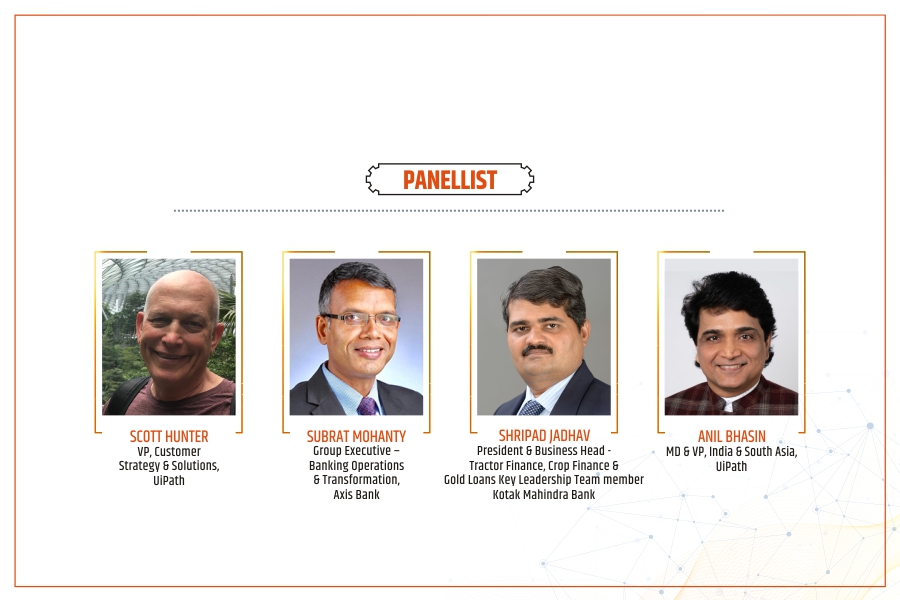The Rapidly Changing Face of Banking in India

In recent times, customer journeys have taken exciting new directions. Branchless banking has gained momentum for daily engagement, KYC has shifted extensively to digital channels and processing of loan origination, application and disbursement has scaled up exponentially using automation. The force driving many of these changes has been smart automation to deliver benefits in productivity, efficiency, safety and convenience.
Forbes India Influencers of Change, in partnership with UiPath, hosted a workshop which showcased thought leaders from the banking sector narrating learnings from their change journeys. They also shared their broader expertise on trends shaping automation in the financial sector, around the world, at this virtual event.
Moderated by Gautam Srinivasan of CNBC TV18, the panellists comprised pundits from the sector, including Scott Hunter, VP, Customer Strategy & Solutions, UiPath; Anil Bhasin, MD&VP, India and South Asia, UiPath; Subrat Mohanty, Group Executive – Banking Operations & Transformation at Axis Bank and Shripad Jadhav, President & Business Head - Tractor Finance, Crop Finance & Gold Loans Key Leadership Team member Kotak Mahindra Bank.
Commenting on the role of digital foresight in his bank’s rapid response to the pandemic, Shripad Jadhav observed, “Our digital journey began a while ago as we launched our flagship product 811 post-demonetisation. We were able to capture the market in a short span of time with this product. Essentially, ‘digital’ is a culture and large organisational-level adoption is the key to crafting success stories.”
Coming to the current times, he remarked, “When the pandemic erupted, the extent of smart phone penetration in India was a boon for us. That, coupled with Jan Dhan accounts and the financial inclusion drive, enabled us to keep expanding while fine-tuning our processes.” He narrated how people in Bharat (semi-urban and rural markets), the segment that he is focused on, were very comfortable using their mobile phones, able to chat online and click and upload pictures. All these were the basic prerequisites for the use of mobile banking. “That’s what debottlenecked the customer onboarding journey for us. It also helped us to understand what customers and segments wanted.” However, his bank maintained its ‘phygital’ approach but was able to decide better where to deploy its resources. “We were a relatively new aged player with an affinity for automation, all along the spectrum from conception to product. We also had multiple channels of automation that were customised regionally. All this gave us a clear head-start.”
With Axis Bank also having considerably scaled up its digital transformation efforts across verticals, Subrat Mohanty offered insights into the bank’s journey, saying, “There are three pillars of our digital strategy. The first is reimagining customer journeys. This involves taking a view from the customer and working backwards to create journeys that work for new-age, digitally-enabled customers, as opposed to the traditional product-centric view. This inversion makes the customer the product manager. At the same time, it involves creation of an entire underlying architecture and the use of digital tools at our end.” The second pillar he referred to was modernising the code so that it could keep up with the slick and seamless front-end. “The back-end core systems must be able to support the volume and velocity of transactions,” he stated. The third pillar was continuing to build future-ready capabilities, within the bank, which go beyond the capabilities of the technology team. “We are building digital capabilities in all teams from analytics and operations to customer-facing people at the front-end, amongst others. All this is delivering results in terms of our ability to digitally source and service over 65% in all verticals,” he added, clarifying that automation was one of the foundational elements.
After the frontrunning bankers shared their views, the digital transformation experts offered their insights from the other side of the table. With two and a half decades of experience in helping corporates along on their digital transformation journeys, Scott Hunter talked about his experience with clients from the banking sector. “Typically, when I talk to bankers, they want to understand how they can undertake automation at scale so that they optimise the return on their investment,” he began. “But before I move forward with an automation strategy, I first understand their vision in terms of where they want to go. Then we explain use cases and describe elements of parallel success stories we’ve seen in the same industry and work towards delineating what we can automate, based on what will bring value to the bank, at different levels. Finally, we figure out what our client wants to measure and put these parameters on a score card, so we can have an ongoing conversation with the bank and the centre of excellence about the progress and impact of the digitisation drive.” He observed that customers are also keen to know the speed at which the transformation could take place. The starting point, however, for all these conversations is the involvement and vision of executive leadership, who will have to drive changes across the organisation.
Anil Bhasin added on another layer of perspective to conversations around automation, which have gone from being a tactical necessity to a business outcome driven approach. He highlighted two broad approaches towards automation in India, saying, “The first is a bottom-up approach. It starts with automation in just three or four processes within one function and the results are watched closely. Then it begins percolating to other functions. Eventually, critical time gets lost. Since automation is a business differentiator, it has to be a comprehensive boardroom conversation.” In the other approach he referred to, the starting point is a strong vision document, crafted with distinct automation goals and deadlines. “There is a clear executive vision that piece-meal execution with multiple tech providers is not the path they want to take. They seek a single provider who is married to business outcomes and not just aiming to sell technology or a product.” The next step, of course, is to pick the low hanging fruit where automation would deliver the best results and that becomes the first implementation milestone on the journey. Such vision is backed by a plan and budget for resources; a centre of excellence is created; people are empowered and things move forward from there with increasing velocity. “We see many banks following the top-down approach because the bottom-up approach didn’t work,” he said.
The discussion went back and forth between the panellists as they shared their views on the use of automation and technology in relationship management between banks and their customers, towards enriching customer journeys; anticipating rather than reacting to customer needs and nudging them towards certain actions; adding on DIY parameters that give customers greater convenience and flexibility; ensuring strong feedback mechanisms; using use cases to avoid reinventing the wheel; the importance of paying attention to vernacular exigencies in India; scaling-up customer experiences and making them frictionless; cycle-time compression to give customers what they want ‘now’; digital assistants to unlock human productivity and potential; using AI/ML for faster and better client experiences through predictions; the entire piece around data, its legacy, volume, quality and usage and a host of other related themes.
They concluded that digitalisation and automation are irreversible trends that are here to stay. These huge business enablers involve creating a culture. More importantly, they entail continuous learning and execution, based on feedback from various stakeholders. Frequent returns to the drawing board are also crucial to check if the transformation journey needed course correction.
The pages slugged ‘Brand Connect’ are equivalent to advertisements and are not written and produced by Forbes India journalists.



